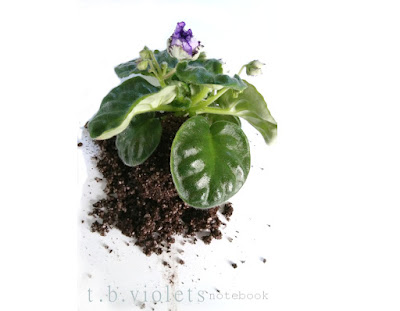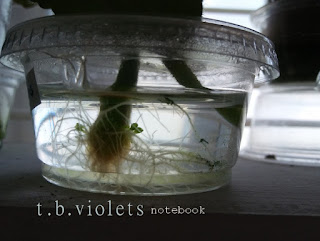How To Repot an African Violet
The most important thing you can do for your violets is to repot them. You can have everything else right, but if your soil is not good, nothing else will matter. A lot of people hate to repot their violets. They are afraid the plant will die from shock and maybe that's happened to you in the past, but there is a trick to repotting that can minimize all that which can keep your plants from going into shock and this is how to do it.
HOW TO REMOVE OLD SOIL FROM ROOTS
I'd like to say that it was the gentle way I removed the old mix off the roots and maybe that was a big part of it but I think it was also that I put all of them on wick watering in a lighter mix that also made them flourish after repotting. But I have been successful at repotting for bottom watering too without transplant shock so it's worked for me both ways.
I did figure out that repotting when the dirt was a little on the dry side made it easier to crumble the old stuff off the roots. I also uncurled the root in the pot. It's not a root ball - it's a root curl. After successfully repotting over 80 violets at one time over several days, you tend to make a few notes.
Roots grow out and down the inside of the pot and then turn in and under toward the center of the pot. So you have to gently uncurl them from turning under at the bottom when repotting a root bound violet. Lift the plant out of the pot and gently remove the soil from the top of the roots under the leaves, and gently uncurl the roots from the bottom center of the mass, unrolling them by turning them down and out.
Once that is done, you gently roll the clumps of dirt between your fingers (while holding it over a trash bin) and gently rub the roots with your fingers to loosen the old dirt. Get as much old dirt off as you can without cutting, pulling or tearing at the roots.
Roots that are unhealthy will easily pull away. Anything dangling way down below the root mass can be cut off but I don't generally trim healthy roots any more when I repot. You can feel the base of the plant stem sticking down on the bottom middle of the plant. I don't cut that stem end either.
If you pull or cut away too much at the roots, force, rake or comb them apart, you could damage them and your plant may suffer shock. Gently uncurl the roots from underneath the plant and rub the dirt off to remove as much as you can. Then you are safe to repot in a light, fresh mix. After you've successfully done this a few times, you won't be afraid to re-pot any violet ever again!
Don't compact the new soil mix when you repot. Spoon it into the pot to about half full and then set your violet on top of that, spreading the roots out evenly. While holding the plant to the height you want it to sit in the pot, spoon dirt all around to about a half inch below the rim of the pot. You may have to remove a few bottom leaves or hold the plant at an angle to get the dirt in. Press the soil down lightly, just enough to hold the violet in place. Let it stay light and airy. Then water as usual.
You do not normally need to remove flowers or bag an otherwise healthy plant when repotting. Yes, you can repot a violet in bloom. If your plant droops afterward, it is in shock and should be bagged for extra humidity while the roots adjust. You may then wish to remove flowers so they don't rot inside the bag while the plant recovers. If you gently uncurl the roots instead of cutting or tearing them, most of the time you can avoid throwing your plant into shock.
YOU SHOULD TRY THIS!
Plants will usually do better if you put them on a wick watering system. You don't have to but it's an option you should explore. Violets grow bigger, are healthier and flower more profusely when they are in a consistently moist growing medium. You can mix your own wicking soil
I have never had a healthy plant suffer shock from repotting when it's been placed on wick watering with the proper wick mix, so I highly recommend it for all violets. Plants that stay evenly moist are not as big a target for pests. Many pests thrive on dead and dry plant material and dry soil can also attract them. I usually run the wick about half way up the inside of the pot.
So don't be afraid to take granny's 20 year old violet and give it a fresh start with a re-potting. Put down a leaf (just in case). Now that you know how to gently uncurl the roots and get all the old dirt off, you are less likely to damage them during the process whether you bottom water or put them on a wick system.
July 7, 2018 - I occasionally put drawings into my posts. I love to photograph violets too but sometimes a simple drawing is all you need. Happy violeting!
July 18, 2018 - RS Grace (shown at the top) is getting ready to bloom and she looks uncomfortable in her pot hugging the sides with her enormous leaves, so I decided to give her a bigger pot. She is growing fast and will be a big girl. Her buds are already nearly an inch across. This is that same little plant about two weeks later after repotting.
August 1, 2018 - RS Grace
HOW TO REMOVE OLD SOIL FROM ROOTS
I'd like to say that it was the gentle way I removed the old mix off the roots and maybe that was a big part of it but I think it was also that I put all of them on wick watering in a lighter mix that also made them flourish after repotting. But I have been successful at repotting for bottom watering too without transplant shock so it's worked for me both ways.
I did figure out that repotting when the dirt was a little on the dry side made it easier to crumble the old stuff off the roots. I also uncurled the root in the pot. It's not a root ball - it's a root curl. After successfully repotting over 80 violets at one time over several days, you tend to make a few notes.
Once that is done, you gently roll the clumps of dirt between your fingers (while holding it over a trash bin) and gently rub the roots with your fingers to loosen the old dirt. Get as much old dirt off as you can without cutting, pulling or tearing at the roots.
Roots that are unhealthy will easily pull away. Anything dangling way down below the root mass can be cut off but I don't generally trim healthy roots any more when I repot. You can feel the base of the plant stem sticking down on the bottom middle of the plant. I don't cut that stem end either.
If you pull or cut away too much at the roots, force, rake or comb them apart, you could damage them and your plant may suffer shock. Gently uncurl the roots from underneath the plant and rub the dirt off to remove as much as you can. Then you are safe to repot in a light, fresh mix. After you've successfully done this a few times, you won't be afraid to re-pot any violet ever again!
Don't compact the new soil mix when you repot. Spoon it into the pot to about half full and then set your violet on top of that, spreading the roots out evenly. While holding the plant to the height you want it to sit in the pot, spoon dirt all around to about a half inch below the rim of the pot. You may have to remove a few bottom leaves or hold the plant at an angle to get the dirt in. Press the soil down lightly, just enough to hold the violet in place. Let it stay light and airy. Then water as usual.
You do not normally need to remove flowers or bag an otherwise healthy plant when repotting. Yes, you can repot a violet in bloom. If your plant droops afterward, it is in shock and should be bagged for extra humidity while the roots adjust. You may then wish to remove flowers so they don't rot inside the bag while the plant recovers. If you gently uncurl the roots instead of cutting or tearing them, most of the time you can avoid throwing your plant into shock.
YOU SHOULD TRY THIS!
Plants will usually do better if you put them on a wick watering system. You don't have to but it's an option you should explore. Violets grow bigger, are healthier and flower more profusely when they are in a consistently moist growing medium. You can mix your own wicking soil
I have never had a healthy plant suffer shock from repotting when it's been placed on wick watering with the proper wick mix, so I highly recommend it for all violets. Plants that stay evenly moist are not as big a target for pests. Many pests thrive on dead and dry plant material and dry soil can also attract them. I usually run the wick about half way up the inside of the pot.
So don't be afraid to take granny's 20 year old violet and give it a fresh start with a re-potting. Put down a leaf (just in case). Now that you know how to gently uncurl the roots and get all the old dirt off, you are less likely to damage them during the process whether you bottom water or put them on a wick system.
~~~~~~~~~~~~~~~~~~~~~~~~~~~~~~~~~~~~~~~~~~~~~~~~~~~~~~~~~~~~~~~~~~~~~~~~
NOTES
July 7, 2018 - I occasionally put drawings into my posts. I love to photograph violets too but sometimes a simple drawing is all you need. Happy violeting!
July 18, 2018 - RS Grace (shown at the top) is getting ready to bloom and she looks uncomfortable in her pot hugging the sides with her enormous leaves, so I decided to give her a bigger pot. She is growing fast and will be a big girl. Her buds are already nearly an inch across. This is that same little plant about two weeks later after repotting.
August 1, 2018 - RS Grace









Comments
Post a Comment